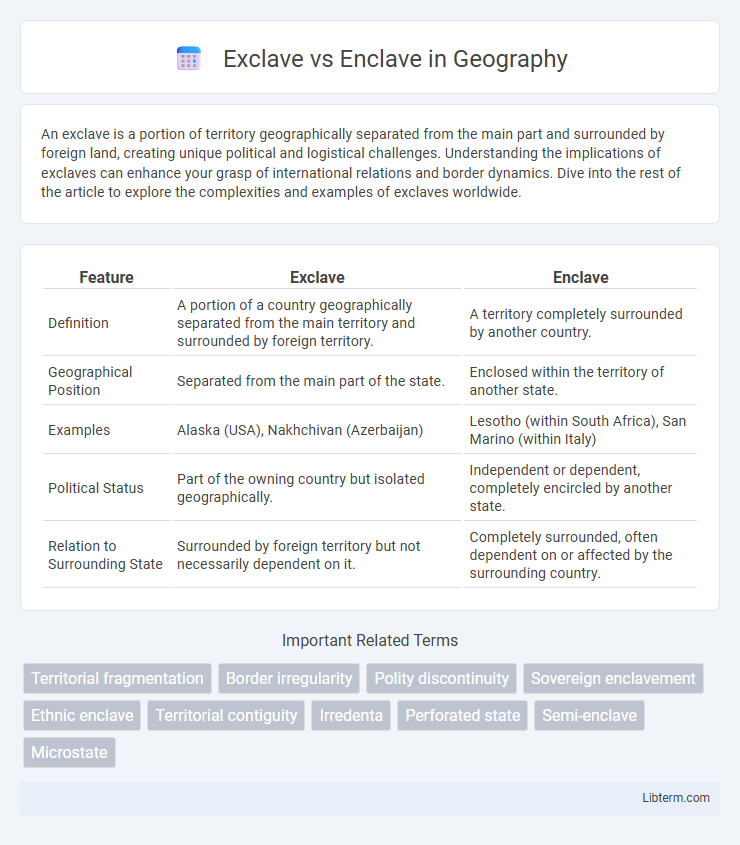An exclave is a portion of territory geographically separated from the main part and surrounded by foreign land, creating unique political and logistical challenges. Understanding the implications of exclaves can enhance your grasp of international relations and border dynamics. Dive into the rest of the article to explore the complexities and examples of exclaves worldwide.
Table of Comparison
| Feature | Exclave | Enclave |
|---|---|---|
| Definition | A portion of a country geographically separated from the main territory and surrounded by foreign territory. | A territory completely surrounded by another country. |
| Geographical Position | Separated from the main part of the state. | Enclosed within the territory of another state. |
| Examples | Alaska (USA), Nakhchivan (Azerbaijan) | Lesotho (within South Africa), San Marino (within Italy) |
| Political Status | Part of the owning country but isolated geographically. | Independent or dependent, completely encircled by another state. |
| Relation to Surrounding State | Surrounded by foreign territory but not necessarily dependent on it. | Completely surrounded, often dependent on or affected by the surrounding country. |
Introduction to Exclaves and Enclaves
Exclaves are portions of a country's territory geographically separated from the main part by surrounding foreign land, while enclaves are territories completely enclosed within another country. These geopolitical entities often arise from historical treaties, conflicts, or administrative decisions, influencing border control and sovereignty complexities. Understanding the distinction between exclaves and enclaves is vital for comprehending international relations and territorial governance.
Defining Exclave: Meaning and Examples
An exclave is a portion of a country geographically separated from the main territory and surrounded by foreign lands, such as Alaska, which is part of the United States but separated by Canada. Exclaves often pose challenges in governance, transportation, and resource management due to their isolation from the central region. Notable examples include Nakhchivan Autonomous Republic of Azerbaijan and Kaliningrad Oblast of Russia, both detached from their respective mainlands.
Defining Enclave: Meaning and Examples
An enclave is a distinct territory or community entirely surrounded by another political entity, often characterized by cultural, ethnic, or linguistic differences from the surrounding area. Examples include Lesotho, an independent country encircled by South Africa, and Vatican City, completely surrounded by the city of Rome. These areas function with separate governance and identity despite being geographically enclosed within a larger state.
Key Differences Between Exclave and Enclave
An exclave is a portion of a country's territory geographically separated from the main part and surrounded by foreign land, whereas an enclave is a territory entirely enclosed within another country's borders. The key difference lies in perspective: an exclave is defined from the viewpoint of the home country, while an enclave is defined from the viewpoint of the surrounding country. Examples include Alaska as an exclave of the USA and Lesotho as an enclave within South Africa.
Historical Origins of Exclaves and Enclaves
Exclaves and enclaves trace their historical origins to complex territorial arrangements arising from feudal divisions, colonial conquests, and diplomatic treaties during the Middle Ages and early modern period. The Peace of Westphalia (1648) and subsequent European treaties often resulted in fragmented sovereignties, creating political enclaves and exclaves such as Baarle-Hertog and Kaliningrad. These territorial anomalies reflect centuries of shifting borders, inheritance laws, and strategic geographic control that shaped modern nation-states.
Famous Exclaves Around the World
Famous exclaves around the world include Kaliningrad, a Russian territory situated between Poland and Lithuania, separated from the mainland by the Baltic Sea. Another notable example is the Nakhchivan Autonomous Republic, an Azerbaijani exclave bordering Armenia, Iran, and Turkey, isolated from the rest of Azerbaijan. The Spanish exclave of Ceuta, located on the northern coast of Africa surrounded by Morocco, highlights the geopolitical significance of exclaves in global territorial disputes.
Notable Enclaves in Global Geography
Notable enclaves in global geography include Lesotho, an independent country entirely surrounded by South Africa, and San Marino, a microstate enclaved within Italy. Other significant examples are Baarle-Hertog, a Belgian enclave within the Netherlands, and the Spanish enclaves of Ceuta and Melilla located on the northern coast of Africa. These enclaves highlight complex political and cultural boundaries shaped by historical treaties and geographic factors.
Political and Cultural Implications
An exclave is a portion of a state geographically separated from the main territory, often creating political challenges related to governance, security, and diplomatic relations with surrounding countries. Enclaves, territories entirely surrounded by another state, present unique cultural implications by fostering distinct identities and potential minority issues within the host country's dominant culture. Both exclaves and enclaves influence regional stability, cross-border cooperation, and minority rights, shaping the political dynamics and cultural landscapes of involved nations.
Challenges Faced by Exclaves and Enclaves
Exclaves and enclaves face significant challenges related to governance, resource access, and security due to their geographical separation from the main territory. Exclaves often encounter logistical difficulties in transportation, communication, and provision of public services because they are isolated within foreign jurisdictions. Enclaves struggle with political tensions and restricted movement caused by their dependency on the surrounding state for economic activities and daily needs.
Exclave vs Enclave: Summary and Conclusion
Exclaves are territories politically attached to a main region but geographically separated by foreign lands, while enclaves are territories entirely surrounded by another state. The distinction is critical in geopolitical contexts, affecting sovereignty, administration, and international relations. Understanding the nuances between enclaves and exclaves helps clarify issues of jurisdiction, security, and cross-border cooperation.
Exclave Infographic

 libterm.com
libterm.com